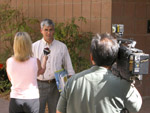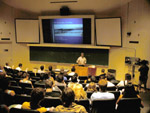Monday, March 29, 2004, possibly the world’s first ever “Geography of Surfing” class began in Buchanan Hall, under the direction of Stuart Sweeney. An avid surfer since childhood, a multi-summer lifeguard on South Coast beaches (with hours and hours to observe water and humans in the field!), Professor Sweeney is credible in both academic and surfing communities. What better person to teach this class?!
Students filled the class at registration time within a little over two days. Apparently, word-of-mouth advertised the class far and wide. Many who tried to register after the class filled emailed and called Sweeney, some pleading their case (for example, “I’m on the surf team!”). The class was to be 90 students. Sweeney agreed to max the number of students to the Fire Marshall’s limit, which allowed in a few more.
On the morning of the first class, the Santa Barbara News-Press gave the “Geography of Surfing” front page display (link to News-Press article). The article included a nice photo of Sweeney holding his surfboard at Campus Point. A television news reporter and videographer showed up just before class to interview Sweeney. The videographer hung out at the front of the classroom at least through half the period. (Stuart admitted afterwards he was not comfortable teaching a class with the TV camera. After the news crew left, he apologized to his students for the intrusion.) KEYT (Channel 3, locally) played a well-done 2-minute story about the class during the 6:00 pm news broadcast that night.
As class began, the weather was unseasonably warm. Students who might rather have been on the waves showed up outside Buchanan Hall, dressed in summer attire: shorts, sunglasses, light tops. One student was barefoot. The television news crew interviewed a few of them. When the previous class streamed out of the classroom, the waiting students packed into the lecture hall. All the chairs filled, and more bodies sat on steps and leaned against walls. When Sweeney asked who was not enrolled yet (who was trying to crash the class), 20 to 30 hands shot up.
Sweeney introduced himself, sharing some of his background and joking about how, when younger, schoolwork used to get in the way of surfing. He spoke about the change in priorities over time, with career and family — but that he still surfed regularly. Although it may be a little unusual for professors to risk opening up about themselves, it was not only pleasant to hear Sweeney share, it was probably a good strategy. If the surfers in the class recognize that Sweeney is, at the core, “one of them” (albeit a few more years down the road), they may more likely apply themselves in the class. Then, actually getting into the material, they are more likely to discover how interesting the study of human and physical processes on the earth really is. They might take more courses in Geography, or even become a major.
The first class period was largely spent going over the syllabus. The class will cover both physical and human geography. Studies will combine field observation with scientific and theoretic investigation. Students are required to get reports on waves five days per week from three buoys that post their data on the internet. Two days per week, they must go to the beach and describe what they see. Both the buoy and field data are to be recorded in a log.
Although there are no texts in the subject, there are two required books: Caught Inside: A Surfer’s year on the California Coast by Duane (1996) and The WebSand WaveCast Guide to Surf Forecasting by Cool (2003). Reading Caught Inside and the WaveCast Guide may be for some a refreshing change to ponderous tomes, and the paperbacks certainly are cheaper than textbooks! Besides the lecture hours and the field work, there is required watching of films Monday evenings. Among the planned movies are some classic surf films and a documentary on a surfer brawl that broke out over territoriality of the waves. And there will be a term project, which is to be done in groups of two to five students.
Mike Vergeer is the lucky graduate student who is “Surfing’s” Teaching Assistant. He holds office hours at the Coral Tree Cafe. Sweeney has two sets of office hours: one in his office in Ellison Hall, the other at Campus Point.
Developing a new class is a tremendous amount of work. Running it the first time is an intense experience, especially since it involves a lot of learning how to do it better the next time. It will be interesting to watch the progression of this class — how curriculum shifts and whether students’ interest in Geography increases. In any case, it’s a top-notch start, with rich and varied materials and activities and a well-qualified instructor. Fortunate are the students who caught the first wave!

.jpg)


